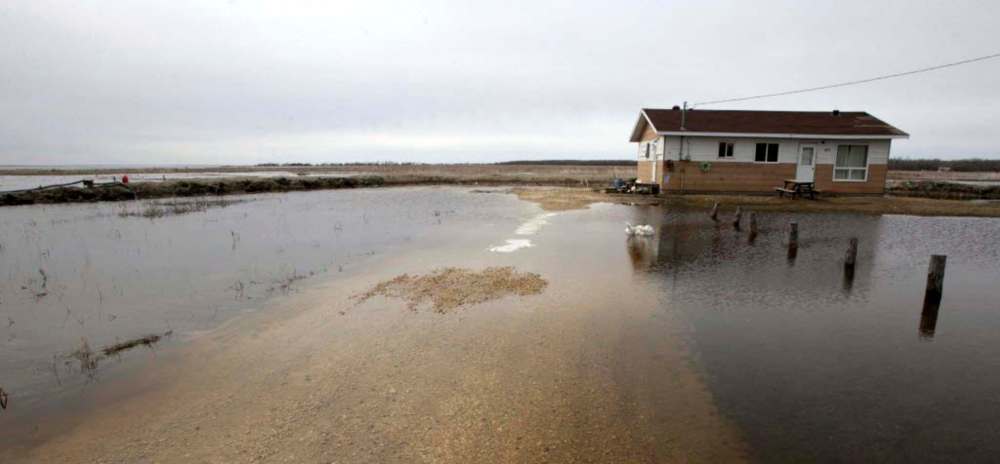Evacuees set to return 8 years after flood
Chiefs cynical about flood channel project
Advertisement
Read this article for free:
or
Already have an account? Log in here »
To continue reading, please subscribe:
Monthly Digital Subscription
$19 $0 for the first 4 weeks*
- Enjoy unlimited reading on winnipegfreepress.com
- Read the E-Edition, our digital replica newspaper
- Access News Break, our award-winning app
- Play interactive puzzles
*No charge for 4 weeks then billed as $19 every four weeks (new subscribers and qualified returning subscribers only). Cancel anytime.
Read unlimited articles for free today:
or
Already have an account? Log in here »
Hey there, time traveller!
This article was published 20/06/2018 (2133 days ago), so information in it may no longer be current.
OTTAWA — Residents of First Nations communities evacuated in 2011 during flooding of Lake St. Martin are on track to return home by November 2019, but some fear this week’s announcement of a channel project to prevent future flooding won’t protect their communities.
In 2011, a devastating flood displaced whole communities, swamped farmland, ruined cottages and businesses and cost governments hundreds of millions of dollars in compensation payments.
The provincial NDP government had ordered the area to be flooded to spare Winnipeg, with its much larger population, from being flooded.

Eighteen First Nations were evacuated, including four that were so damaged, residents couldn’t return home: Pinaymootang, Little Saskatchewan, Lake St. Martin and Dauphin River. Data published this week by Indigenous Services Canada show few evacuees have gone home in the past seven years.
For example, Lake St. Martin First Nation has had just 266 of 1,306 evacuees return home, as of late May, and another 175 are expected to go home this summer.
“It’s anticipated the evacuation will end in November 2019,” the department said, though the wastewater facility and fire hall have been completed.
The three smaller communities are on track to be settled by the end of this year.
The department says 1,612 people were waiting to return home as of late May, plus almost 100 from other reserves.
On Monday, the provincial and federal governments announced they had earmarked a combined $540 million to constructed two long-awaited outlet channels that will link Lake St. Martin, Lake Manitoba and Lake Winnipeg. Construction could start as soon as fall 2019.
But chiefs from the local First Nations say they weren’t invited to Monday’s announcement, reportedly sparking fears the project won’t keep their communities safe or distract from the return effort.
Little Saskatchewan Chief Hector Shorting told APTN he fears the channels won’t prevent flooding.
“A lot of Interlake chiefs oppose this because they feel it will flood their communities still,” Shorting said. (He did not respond to interview requests Wednesday and Thursday.)
Shorting also said both levels of government ought to focus on returning the 332 remaining evacuees to his community; just 100 have done so thus far. That’s because less than half of 170 housing units have been built so far, and because of ongoing talks with the province to determine land easements.
“I’m not open to any agreements at this point, because there’s still a lot outstanding,” Shorting told APTN.
Lake Manitoba Chief Cornell McLean also told the network the province ought to have resolved the land swap before proceeding, because some of the land is too saturated to be built upon. But he believed the outlets would help secure his community.
A third chief from a nearby First Nation told the Free Press he also had concerns with the land-easement issue, but refused to speak on record, claiming it would distract from the resettlement effort.
A spokesman for the Manitoba government wrote Thursday it plans to reach out over the coming months.
“Consultations have taken place or are presently underway with 30 Indigenous communities, as well as the Manitoba Metis Federation. This work is well underway, and consultations remain ongoing,” the statement reads.
The four First Nations signed a $90-million settlement with Manitoba and Ottawa in January.
Meanwhile, senior provincial officials say the outlet project got a boost from federal Environment Minster Catherine McKenna, after Premier Brian Pallister asked the Liberals in April to speed up the review by the Canadian Environmental Assessment Agency.
McKenna’s spokeswoman said she respected the agency’s independence, but also opted against adding months to the review.
“This was a normal agency-led review and the minister did not intervene in the agency-led review process or fast-track the process. However, the minister had received requests to refer the project to a review panel, and declined to exercise her discretion to do so,” Julia Kilpatrick wrote.
dylan.robertson@freepress.mb.ca



